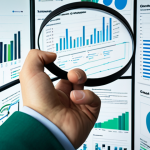Navigating the ocean of data in today’s business landscape can feel like trying to map the stars with just your eyes. For any business analyst worth their salt, the right data analysis tools aren’t just helpful; they’re absolutely indispensable.
I’ve personally seen how a powerful suite of tools can transform raw numbers into actionable insights, but choosing the right ones in this rapidly evolving tech space is a challenge in itself.
It’s truly incredible how much the game has changed. What used to be a niche skill for a select few has exploded into a core competency, driven by the sheer volume of information we now generate daily.
From robust BI platforms that practically think for you, leveraging AI to spot trends before you even know they exist, to user-friendly visualization tools that turn complex datasets into compelling narratives, the options are broader than ever.
This shift isn’t just about efficiency; it’s about staying competitive and making predictions that genuinely steer a company forward in an unpredictable market.
Forget simply looking at what happened yesterday; the focus is squarely on anticipating tomorrow, and thankfully, the tools are finally catching up to that ambition.
Let’s get into the specifics.
In the world of business analysis, having the right tools isn’t just about efficiency; it’s about making smarter decisions faster, uncovering hidden opportunities, and ultimately, driving growth.
I’ve often felt like a digital detective, sifting through mountains of data to find that one crucial clue, and without the right equipment, that task would be utterly impossible.
The sheer volume and complexity of data today demand a robust toolkit, and what truly excites me is how these tools are evolving, making sophisticated analysis accessible to more people than ever before.
It’s no longer just for the tech gurus; it’s becoming a core skill for every analyst who wants to make a real impact.
The Unsung Heroes: Core Data Analysis Platforms

When I first started in this field, I remember feeling overwhelmed by the sheer number of platforms available, each promising to be the “one-stop shop.” But after years of getting my hands dirty with everything from enterprise-level suites to niche open-source solutions, I’ve come to appreciate the foundational importance of core data analysis platforms. These aren’t just software; they’re comprehensive ecosystems designed to handle the entire data lifecycle, from collection and cleaning to sophisticated modeling and reporting. They act as the central nervous system for any data-driven operation, allowing analysts to move beyond basic number crunching into predictive insights. What truly stands out to me is how these platforms have matured, integrating AI and machine learning capabilities that were once the domain of highly specialized data scientists, making them an indispensable part of a business analyst’s daily workflow. It’s truly amazing to witness the transformation.
1. The Enduring Power of Microsoft Excel
Despite the rise of flashier tools, Excel remains, in my humble opinion, an absolutely critical tool in any business analyst’s arsenal. I know, I know, some might scoff, but hear me out. It’s incredibly versatile for quick data manipulation, ad-hoc analysis, and small to medium-sized datasets. I’ve personally used it countless times for initial data exploration, creating pivot tables to quickly identify trends, and even building complex financial models. Its accessibility means almost everyone has some level of familiarity with it, making collaboration easier for certain tasks. The power of its built-in functions, from VLOOKUP to SUMIFS, is unparalleled for immediate answers, and its charting capabilities, while perhaps not as aesthetically refined as dedicated BI tools, are perfectly adequate for many internal reports. Don’t underestimate its enduring utility; it’s the reliable workhorse that often gets overlooked but always delivers.
2. Robustness of SQL and Database Management Systems
If Excel is your everyday vehicle, then SQL and proper database management systems (DBMS) are your high-performance, long-haul trucks. Mastering SQL (Structured Query Language) has been, without a doubt, one of the most impactful skills I’ve ever learned. It allows you to directly interact with vast databases, pulling precisely the data you need, transforming it, and joining disparate datasets with remarkable efficiency. From my experience, trying to perform complex queries or manipulate large volumes of data without SQL is like trying to empty an ocean with a thimble – it’s just not practical. Whether it’s MySQL, PostgreSQL, SQL Server, or Oracle, understanding the underlying principles of relational databases and how to query them is fundamental for any analyst serious about their craft. It empowers you to extract the raw material for all your other analyses, ensuring data integrity and consistency right from the source.
Visualizing the Unseen: The Power of Business Intelligence Tools
Once you’ve wrangled your data, the next critical step is to make it comprehensible, impactful, and actionable. This is where Business Intelligence (BI) tools truly shine. I often describe them as the storytellers of the data world. It’s one thing to have a spreadsheet full of numbers, but it’s an entirely different experience to see those numbers come alive in a vibrant, interactive dashboard that instantly highlights trends, anomalies, and opportunities. I’ve witnessed countless times how a well-designed dashboard can transform a dry presentation of facts into an engaging narrative that captures attention and drives decision-making. These tools aren’t just about pretty charts; they’re about democratizing data, allowing stakeholders across an organization to explore insights for themselves, reducing the bottleneck of constant requests to the analytics team. The real magic happens when people can intuitively interact with data and grasp complex information at a glance.
1. Tableau’s Intuitive Design and Impactful Dashboards
Tableau holds a special place in my heart for its sheer visual power and intuitive drag-and-drop interface. When I first started using it, I was amazed at how quickly I could transform raw data into stunning, interactive visualizations. Its ability to connect to a multitude of data sources and its strong focus on visual best practices make it a standout. I’ve used Tableau to create everything from executive dashboards tracking key performance indicators in real-time to detailed operational reports that helped teams identify inefficiencies. The community around Tableau is also incredibly vibrant and supportive, meaning there’s always a resource or a solution available if you run into a tricky visualization challenge. It truly empowers analysts to not just present data, but to tell compelling stories with it, making complex insights accessible to a broader audience who might not be data-savvy themselves.
2. Power BI: Microsoft’s Enterprise-Grade Solution
For organizations deeply integrated into the Microsoft ecosystem, Power BI is often the natural choice, and for good reason. What I appreciate most about Power BI is its seamless integration with other Microsoft products like Excel and Azure, making data flow incredibly smooth for many businesses. It’s an incredibly powerful tool for data modeling, especially with its robust DAX (Data Analysis Expressions) language, which allows for complex calculations and custom measures. I’ve personally seen how Power BI’s capabilities can scale from individual desktop use to enterprise-wide reporting, handling massive datasets with impressive efficiency. Its cost-effectiveness, especially for existing Microsoft users, combined with its continuous updates and growing features, makes it a formidable contender in the BI space. It offers a fantastic balance of depth for technical users and accessibility for business users who need quick insights.
Beyond the Spreadsheet: Embracing Advanced Analytics & Statistical Tools
While core platforms and BI tools are essential for understanding “what happened,” true competitive advantage often comes from figuring out “why it happened” and, crucially, “what will happen next.” This is where advanced analytics and statistical tools become absolutely indispensable. My journey as an analyst truly took a leap forward when I began exploring these deeper layers of data. It’s about moving from descriptive and diagnostic analysis to predictive and prescriptive models, allowing businesses to not just react but proactively shape their future. I recall a project where, by leveraging statistical modeling, we were able to forecast customer churn with significant accuracy, allowing the marketing team to intervene with targeted retention campaigns. This kind of impact, directly influencing revenue and strategic direction, is what makes venturing into advanced tools so incredibly rewarding. It’s an investment in understanding the very pulse of your business.
1. Statistical Software: R and Python for Deeper Insights
When standard BI tools hit their limit, or when you need highly customized statistical models, R and Python are the languages I turn to. These open-source powerhouses, with their vast libraries (like pandas, NumPy, scikit-learn in Python; dplyr, ggplot2 in R), offer unparalleled flexibility and depth for statistical analysis, machine learning, and complex data manipulation. I’ve used Python extensively for everything from advanced regression analysis to building custom data cleaning scripts that automate tedious tasks. The learning curve can be steeper than with drag-and-drop tools, no doubt, but the analytical power you unlock is immense. It allows you to move beyond pre-defined functions and truly build bespoke solutions tailored to unique business problems. The ability to craft your own algorithms and perform truly novel analyses is incredibly empowering and sets you apart as an analyst.
2. Specialized Tools for Predictive Modeling
For specific predictive tasks, specialized tools often offer a more streamlined approach than coding from scratch. Platforms like SAS, SPSS, or even more modern cloud-based solutions like Google Cloud AI Platform or AWS SageMaker, provide powerful environments for building and deploying predictive models. While I often lean on Python for its flexibility, these dedicated platforms excel in their robust statistical libraries and often feature user-friendly interfaces that abstract away some of the more complex coding. I’ve found them particularly useful for large-scale forecasting projects or when collaborating with teams who might not have deep coding expertise but need to interpret model outputs. The accuracy and speed with which these tools can process large datasets for machine learning applications are truly impressive, turning data into actionable predictions that can significantly impact strategic decisions.
The AI/ML Revolution: Predictive Power at Your Fingertips
It feels like just yesterday AI and Machine Learning were concepts confined to academic papers and futuristic movies, but now, they’re fundamentally reshaping how business analysts approach data. This isn’t just hype; it’s a tangible shift that I’ve personally experienced in how insights are generated and consumed. AI-powered tools are taking over repetitive tasks, automating data preparation, and even suggesting insights that a human analyst might miss due to cognitive biases or simply the sheer volume of data. It’s no longer about whether you should use AI, but how deeply you integrate it into your analytical workflow to stay competitive. The beauty of these advancements is that they’re increasingly embedded within existing platforms, making sophisticated capabilities accessible without needing a PhD in computer science. This truly allows analysts to focus on higher-value activities like interpreting results and strategizing, rather than getting bogged down in manual processes.
1. Automated Insights and Anomaly Detection
One of the most exciting applications of AI in data analysis is automated insight generation and anomaly detection. Many modern BI tools now come with built-in AI capabilities that can automatically scan your data, identify significant trends, outliers, and correlations, and even explain them in plain language. I remember a project where an AI feature in our BI tool flagged an unusual dip in sales for a specific product line, which we later traced back to a logistics issue we hadn’t noticed manually. This capability is like having an extra pair of eyes, constantly monitoring your data for anything out of the ordinary, freeing up analysts to investigate the “why” rather than spending hours sifting for the “what.” It significantly reduces the time to insight and helps proactively address issues before they escalate, which is an absolute game-changer for responsive businesses.
2. Natural Language Processing (NLP) for Unstructured Data
The vast majority of data generated today is unstructured – think customer reviews, social media comments, emails, or call transcripts. Traditionally, analyzing this data was a monumental task, but with the rise of Natural Language Processing (NLP) powered by AI, it’s becoming incredibly accessible. I’ve used NLP tools to analyze thousands of customer feedback entries, automatically identifying common themes, sentiment, and emerging issues that would have taken weeks to manually categorize. This allows businesses to truly listen to their customers at scale and derive actionable insights from qualitative data. It transforms mountains of text into quantifiable metrics, enabling richer, more holistic analysis that combines both numerical and textual data, providing a much deeper understanding of customer behavior and market sentiment. This is where the real empathetic insights come from, bridging the gap between numbers and human experiences.
Data Governance & Security: Protecting Your Goldmine
While the focus is often on the glamour of insights and predictions, the bedrock of all effective data analysis is robust data governance and stringent security. I cannot stress this enough: without trust in your data, every analysis, every model, every dashboard is fundamentally flawed. In my career, I’ve seen firsthand the chaos and bad decisions that arise from unreliable or insecure data. It’s like building a skyscraper on quicksand. Data governance isn’t just about compliance; it’s about establishing clear rules, roles, and responsibilities for data management, ensuring data quality, consistency, and accessibility across the organization. Security, on the other hand, is about protecting that valuable asset from breaches, unauthorized access, and misuse. These aren’t just IT concerns; they are critical business imperatives that directly impact the validity of your analysis and the reputation of your company. It’s an ongoing commitment, not a one-time setup.
1. Establishing Data Quality and Integrity
Poor data quality is an analyst’s worst nightmare. I’ve spent countless hours cleaning messy datasets, fixing inconsistencies, and tracing data lineage to understand where errors might have crept in. This is why tools and processes for ensuring data quality and integrity are paramount. They include data profiling tools that help identify anomalies, data cleansing solutions that automate error correction, and robust data validation frameworks that prevent bad data from entering your systems in the first place. My personal experience has taught me that investing in data quality upfront saves an immense amount of time and headaches down the line. It ensures that the insights you generate are based on accurate information, giving stakeholders confidence in the decisions they make. A strong data quality foundation means you can truly trust the story your data is telling.
2. Prioritizing Data Privacy and Compliance
In today’s regulatory landscape, data privacy isn’t just a good practice; it’s a legal necessity. With regulations like GDPR, CCPA, and many others, understanding and implementing tools for data privacy and compliance is non-negotiable. This involves data masking, anonymization techniques, access controls, and robust audit trails to ensure sensitive information is protected and used ethically. I’ve been involved in projects where non-compliance could have resulted in significant fines and reputational damage, so I’m acutely aware of the stakes. Analysts must be educated on these regulations and use tools that facilitate compliance, ensuring that data is handled responsibly from collection to destruction. It’s about building trust with your customers and operating within legal and ethical boundaries, which ultimately fortifies your position as a trusted data professional.
Collaboration & Cloud: Analyzing Together, Anywhere
The days of siloed data analysis, with one analyst hoarding all the spreadsheets on their desktop, are long gone. Today’s business environment demands collaborative, real-time insights that can be accessed and contributed to by teams regardless of their physical location. This is where cloud-based data analysis tools and platforms truly revolutionize the way we work. I’ve personally experienced the frustration of sending large files back and forth, dealing with version control issues, and struggling to share dynamic dashboards. Cloud solutions eliminate these headaches, providing a centralized, accessible environment where multiple analysts can work on the same dataset or model simultaneously. This fosters a more agile and responsive analytical process, where insights can be generated, reviewed, and disseminated far more rapidly. It’s a game-changer for dispersed teams and contributes significantly to the speed of business decision-making.
1. Shared Workspaces and Version Control
Cloud platforms like Google Workspace (Sheets, Data Studio), Microsoft 365 (Excel Online, Power BI Service), and dedicated cloud data warehouses (Snowflake, BigQuery) offer invaluable shared workspaces. What I find particularly liberating is the built-in version control and collaboration features that these platforms provide. No more “Final_Report_V2_FinalFinal.xlsx” chaos! You can track changes, revert to previous versions, and comment on analyses in real-time, making teamwork incredibly efficient. I’ve led projects where team members were in different time zones, and these cloud-native collaboration features were absolutely essential for maintaining a cohesive workflow and ensuring everyone was working from the most current and accurate data. It reduces friction, improves data governance, and accelerates the entire analytical pipeline, allowing teams to deliver insights much faster.
2. Scalability and Accessibility of Cloud Data Warehouses
The ability of cloud data warehouses to scale almost infinitely is, quite frankly, mind-boggling. When I first encountered data bottlenecks with on-premise servers, moving to solutions like Snowflake or Amazon Redshift felt like stepping into a new dimension. These platforms can handle petabytes of data with incredible speed, allowing for complex queries and analyses that would simply cripple traditional systems. Furthermore, their accessibility means that authorized users can access the data from anywhere, on any device, as long as they have an internet connection. This has been transformative for businesses with global operations or remote workforces. It democratizes access to large datasets, breaking down traditional barriers and empowering a broader range of users to leverage data for their decision-making, which in turn leads to a more data-driven organizational culture.
Choosing Your Arsenal: A Strategic Approach
Navigating the vast ocean of data analysis tools can feel like an endless quest, and I’ve certainly been there, trying to figure out which tool is “the best.” But what I’ve learned through years of experience is that there’s no single silver bullet. The “best” tool is always the one that best fits your specific needs, your organization’s infrastructure, your team’s skill set, and your budget. It’s less about adopting every shiny new tool and more about strategically building a cohesive arsenal that addresses your unique challenges. This requires a thoughtful assessment, often involving pilot projects and proof-of-concepts, to truly understand how a tool will integrate into your existing workflows and deliver tangible value. Remember, tools are enablers; your analytical mindset and ability to ask the right questions are what truly drive value. Always start with the problem you’re trying to solve, not the tool itself.
1. Assessing Your Business Needs and Data Volume
Before you even think about specific tools, you absolutely must assess your business needs. Are you dealing with small, static datasets for ad-hoc reports, or are you grappling with real-time streaming data from millions of IoT devices? Are your analyses primarily descriptive, or do you need advanced predictive capabilities? The volume, velocity, and variety of your data (the “three Vs”) will largely dictate the type of tools you need. From my experience, many companies over-invest in complex, expensive solutions when a simpler, more agile tool would suffice, or conversely, try to force basic tools to handle enterprise-level data, leading to frustration and inefficiency. Understanding your current and future data landscape is the first, crucial step in building an effective analytics strategy. Don’t fall into the trap of buying a Ferrari when a reliable sedan is all you need for your daily commute.
2. Considering Team Skill Sets and Scalability
Another critical factor, which often gets overlooked, is your team’s existing skill set and the organization’s capacity for learning new tools. Investing in a cutting-edge platform is pointless if your team lacks the expertise to use it effectively, or if the learning curve is so steep that adoption rates plummet. I always advocate for a balanced approach: leverage existing strengths while also strategically upskilling the team in tools that offer significant long-term advantages. Furthermore, think about scalability. Will the tool grow with your business? Can it handle increased data volume, more complex analyses, and a larger user base without requiring a complete overhaul? A tool that works for a small startup might crumble under the demands of a large enterprise. Choose tools that offer a clear growth path and integrate well within your broader tech stack, ensuring longevity and future-proofing your analytical capabilities.
Here’s a quick overview of some popular tools and their common applications:
| Tool Name | Primary Use Cases | Key Features & Benefits | Typical Learning Curve |
|---|---|---|---|
| Microsoft Excel | Ad-hoc analysis, small datasets, financial modeling, quick charting | Ubiquitous, flexible formulas, pivot tables, VBA scripting | Low (Basic), Medium (Advanced functions/VBA) |
| SQL (Databases like MySQL, PostgreSQL) | Data extraction, cleaning, transformation from large databases | Precise data querying, joining complex datasets, data integrity | Medium |
| Tableau | Interactive dashboards, advanced visualizations, data storytelling | Intuitive drag-and-drop, strong visual analytics, large community support | Medium |
| Microsoft Power BI | Business intelligence, enterprise reporting, data modeling (DAX) | Seamless Microsoft integration, robust data modeling, cost-effective for MS users | Medium |
| Python (Pandas, NumPy, Scikit-learn) | Advanced statistical analysis, machine learning, data automation | Highly flexible, vast libraries, strong community, deep analytical power | High |
| R (dplyr, ggplot2) | Statistical computing, data visualization, academic research | Specialized for statistics, excellent for custom visualizations, open-source | High |
Mastering the Data Workflow: From Ingestion to Insight
Having a collection of powerful tools is certainly important, but what truly separates a good analyst from a great one is their ability to orchestrate these tools within a seamless data workflow. It’s not about isolated pieces of software; it’s about how they interact and contribute to the entire analytical pipeline, from the moment raw data is collected to the point where actionable insights are delivered and monitored. I’ve found that neglecting any stage of this workflow can compromise the integrity and timeliness of your insights. It’s a continuous cycle of data acquisition, preparation, analysis, visualization, and deployment. The goal is to minimize manual handoffs, automate repetitive tasks, and ensure data flows smoothly and accurately through each stage. This holistic view is crucial for transforming a series of disconnected steps into a high-performance analytical engine that consistently delivers value to the business.
1. Data Integration and ETL Processes
Before you can even begin to analyze, you need to get your data in one place, and often, in a usable format. This is where data integration and ETL (Extract, Transform, Load) processes come in. I’ve spent countless hours building and refining ETL pipelines, whether it’s pulling data from various source systems, cleaning it, transforming it into a consistent schema, and loading it into a data warehouse. Tools for this range from specialized ETL platforms like Informatica or Talend to cloud-native services like AWS Glue or Azure Data Factory. My experience has shown that robust ETL is the unsung hero of data analysis; it ensures that your data is clean, standardized, and readily available for analysis. Without a solid ETL foundation, your analysis will always be a struggle against dirty or fragmented data, leading to inaccurate insights and wasted effort. It’s the critical first step in building a reliable data ecosystem.
2. Monitoring and Iteration for Continuous Improvement
Finally, data analysis is not a one-and-done event. It’s an ongoing, iterative process. Once you’ve delivered an insight or deployed a dashboard, the work isn’t over. You need to continuously monitor its performance, gather feedback from users, and iterate to refine your analyses and models. Are the dashboards being used as intended? Are the insights still relevant? Has the underlying data changed? I’ve learned that regular review and adaptation are key to maintaining the value of your analytical outputs. This involves setting up monitoring tools for data quality, performance of your dashboards, and the accuracy of your predictive models. It’s about building a feedback loop that allows you to constantly improve, ensuring that your data analysis efforts remain aligned with evolving business needs and continue to drive meaningful impact. This proactive approach ensures your analytical endeavors are living, breathing assets, not stagnant reports.
Wrapping Up
As we’ve journeyed through the expansive world of business analysis tools, it becomes abundantly clear that our success isn’t just about having the flashiest software. It’s truly about wielding the right instruments for the job, understanding their strengths, and seamlessly integrating them into a coherent workflow. My hope is that this deep dive has empowered you, not just with knowledge of individual tools, but with a strategic framework for building an analytical arsenal that propels your career and your business forward. The landscape of data is ever-evolving, but with a curious mind and the right toolkit, you’re not just ready for the challenges—you’re poised to uncover incredible opportunities and drive real, impactful change.
Useful Information to Know
1. Always prioritize understanding the business problem over immediately jumping to a tool. A deep comprehension of the “why” will guide you to the most effective “what” (tool) and “how” (analysis method).
2. Don’t be afraid to specialize. While a broad understanding of many tools is beneficial, becoming exceptionally proficient in one or two core platforms relevant to your industry can make you an invaluable asset.
3. Continuously invest in your learning. The data analysis field is dynamic; new tools, techniques, and best practices emerge constantly. Online courses, community forums, and certifications are your best friends.
4. Networking with other analysts is crucial. Sharing experiences, challenges, and solutions with peers can provide fresh perspectives and accelerate your problem-solving abilities far beyond what you can learn alone.
5. Remember that data analysis is as much an art as it is a science. The ability to tell a compelling story with your data, translating complex insights into actionable narratives for non-technical stakeholders, is truly where the magic happens.
Key Takeaways
The landscape of business analysis tools is vast and varied, from foundational platforms like Excel and SQL to advanced AI/ML solutions. Choosing the right tools requires a strategic assessment of business needs, data volume, and team skill sets. Effective data analysis relies on a seamless workflow, from robust data integration to continuous monitoring and iteration. Prioritizing data quality, privacy, and security is paramount for trusted insights, while cloud and collaborative tools enhance efficiency and accessibility. Ultimately, the synergy between a thoughtful analytical mindset and a well-chosen toolkit is what drives impactful, data-driven decisions and shapes the future of business.
Frequently Asked Questions (FAQ) 📖
Q: Given the explosion of options, what’s the biggest hurdle businesses face when selecting data analysis tools today, and how has this challenge evolved from the past?
A: Honestly, it used to be about finding any tool that did the job. Now? It’s like being a kid in a candy store, but every candy looks delicious, and you’ve only got enough allowance for one.
The real challenge, I’ve found, isn’t just the sheer volume of choices; it’s discerning what genuinely moves the needle for your specific business needs versus what’s just flashy tech.
I remember back when a simple spreadsheet and pivot tables felt cutting-edge for many small businesses – it really wasn’t that long ago! But the stakes are so much higher now.
It’s not just about getting data; it’s about getting ahead. You’re looking for predictive power, not just historical reporting, and that demands a much more strategic, nuanced selection process.
It’s exhilarating, but can definitely feel overwhelming if you don’t know what questions to ask yourself.
Q: The text mentions focusing “squarely on anticipating tomorrow.” Why is this shift from historical analysis so crucial for businesses now?
A: Oh, this is where the rubber meets the road, isn’t it? For years, businesses were content to just look in the rearview mirror – ‘What happened last quarter?
What did we sell yesterday?’ And that was fine for a stable market. But the world we operate in today? It’s a whirlwind.
Supply chain hiccups, sudden shifts in consumer behavior, competitors popping up overnight… relying on yesterday’s data to navigate tomorrow is like trying to drive through a fog using only your side mirrors.
I’ve personally been in meetings where a late market trend detection meant losing out on a significant revenue stream, simply because we were analyzing past performance rather than predicting future demand.
The competitive edge isn’t just about reacting quickly; it’s about proactively shaping your strategy. Tools that leverage AI to spot micro-trends or forecast demand fluctuations before they become full-blown crises are gold.
It’s about minimizing risk and maximizing opportunity, which, let’s be real, is what keeps a business afloat and thriving in these unpredictable waters.
Q: The text highlights robust BI platforms leveraging
A: I and user-friendly visualization tools. How do these modern tools, particularly with AI, help transform complex data into “compelling narratives” and actionable insights?
A3: This is the magic trick, honestly. Think about it: you’ve got terabytes of raw data – numbers, dates, transaction IDs. Trying to make sense of that by hand is like reading a phone book cover to cover and expecting a thrilling novel.
That’s where AI-powered BI platforms and visualization tools come in. I’ve seen these platforms take a mountain of sales data, automatically identify, say, a surge in demand for eco-friendly products in a specific demographic after a recent influencer campaign, and then present that finding not just as a number, but as a clear, concise story.
The AI spots the patterns and anomalies that a human might miss or take days to find. Then, the visualization tools? They’re the storytellers.
They don’t just dump charts; they allow you to craft a narrative, highlighting key insights with interactive dashboards that make complex information immediately digestible.
It’s about moving from ‘here are the numbers’ to ‘here’s what these numbers mean for our next big move.’ It empowers decision-makers who aren’t data scientists to grasp critical insights, leading to faster, more confident actions.
It’s truly transformative for collaborative decision-making.
📚 References
Wikipedia Encyclopedia
구글 검색 결과
구글 검색 결과
구글 검색 결과
구글 검색 결과
구글 검색 결과



